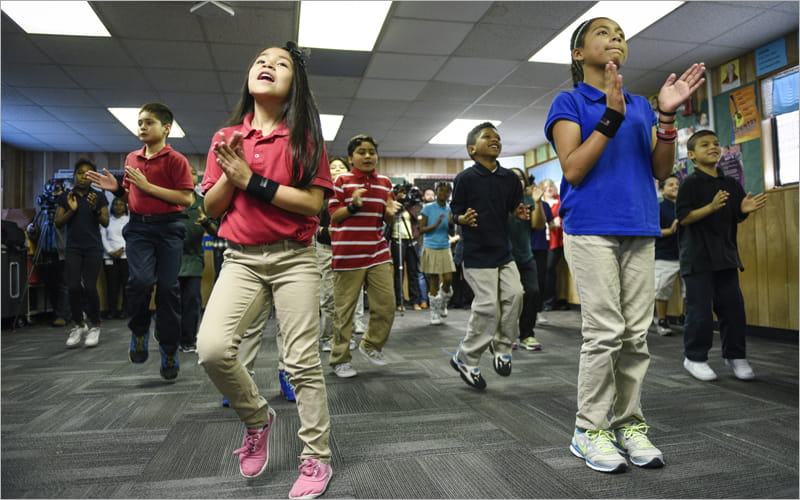Preventing Chronic Disease in Kids Through Lifestyle Change

At a YMCA in suburban Dallas, the lights dim. Music pulses through the gym. A group of kids jump through hula hoops, carry balls without their hands, and skip from wall to wall.
It all looks more like a field day than a seminar, especially one on being healthy.
And that’s the point.
“Kids don’t want another lecture,” said Alex Reid, director of disease management at Children’s Health in Dallas. “They want to have fun. And if they’re enjoying themselves, the learning follows, and when they get home, they want to do the same thing.”
The afterschool class is one part of Get Up & Go, a free program at Children’s Health taking on childhood obesity in neighborhoods instead of clinics. The healthy lifestyle initiative encompasses a variety of individual programs offered at more than a dozen locations — community centers, recreational facilities, and even online. Kids and families learn about healthy food and cook tasty meals in a community context to kickstart healthy habits and help prevent chronic disease.
“As a health educator, I can't force kids to learn, but I can create the right environment for learning to take place," said Brenda Olvera, a health educator who teaches the afterschool program.
Around 86% of kids in Get Up & Go adopt healthier habits, according the hospital’s data. Ultimately, that means less risk for coronary artery disease, type 2 diabetes, fatty liver disease, and other chronic illnesses related to obesity.
“I had my doubts if the program really worked,” said the mother of a 10-year-old. “After a scheduled checkup with my child’s pediatrician, I received a letter stating that her BMI had improved. I shed tears when I read it. It might not be much for some, but it meant a lot for us."
Healthy living through healthy choices
At Get Up & Go’s flagship weight management program, parents and children attend 90-minute classes together for 10 weeks, learning how to read food labels, choose healthy foods, and stay active.
Kids and families tour grocery stores and learn the difference between “go” (eat all you want), “slow” (eat in moderation), or “whoa” (only special occasions) foods.
Each week they’re given new healthy snacks, like veggies and hummus, to broaden their palates.
They discover the facts of fast food, the tricks of marketers, the size of a serving. Many are shocked to learn how many servings of popcorn are in a single bag or what all goes into a chicken nugget.
By the program’s end, 63% show a decrease in BMI.
“But maintaining one’s weight is still a win,” said Mayuri Patel Garg, MPH, who manages Children’s Health’s community weight management programs. “If a child stays the same weight while continuing to grow, that BMI drops naturally.”

During the Family Cooking Program, kids ages 9 and up don aprons and wield spatulas as they cook a real meal alongside their parents.
Led by registered dietitians, the program covers everything from knife skills to portion sizes to ratios of food types for balanced meals. Popular recipes include homemade pizza with whole wheat crust and black bean burgers served on whole grain buns.
“When kids help prepare the food themselves, they’re more likely to eat it,” Reid said. “And after class, families sit down together and eat what they’ve made. With busy schedules some families may not often get the opportunity to eat together as a family.”
There’s an online diabetes prevention course for children with a family history of Type 2 diabetes or who may have an elevated A1c. Another nutrition program tailored for children with neurodivergence gently encourages them to try new foods or sit at the family table. Monthly demonstrations at food banks show families how to cook meals with ingredients straight from the bank’s shelves.
One class focuses on mental health and bullying. “Children with excess weight tend to be bullied more often than other children,” Reid said.
Parents receive weekly calls from coaches, checking in with encouragement and reminders. YMCA memberships are included with many programs, giving families access to gyms and pools.
Though Get Up & Go begins with a patient referral, it’s a family affair.
“It’s not just about the kids,” Reid said. “It is important for everyone in the household to understand what a healthy lifestyle looks like.”
They leave the program not with prescriptions but with practical tools and a sense of community that lasts long after the program ends.
“They see other families going through the same struggle they’re going through, and that's where they start building relationships,” Patel Garg said. “They send photos, they keep meeting up, they share recipes. It becomes a support system.”
In response to the Make America Healthy Again (MAHA) Commission’s report on child health, the Children’s Hospital Association is highlighting ways children’s hospitals are helping children live longer and healthier lives by confronting the root causes of chronic illnesses.
Contact Us
About Children's Hospital Association
Children’s Hospital Association is the national voice of more than 200 children’s hospitals, advancing child health through innovation in the quality, cost, and delivery of care.